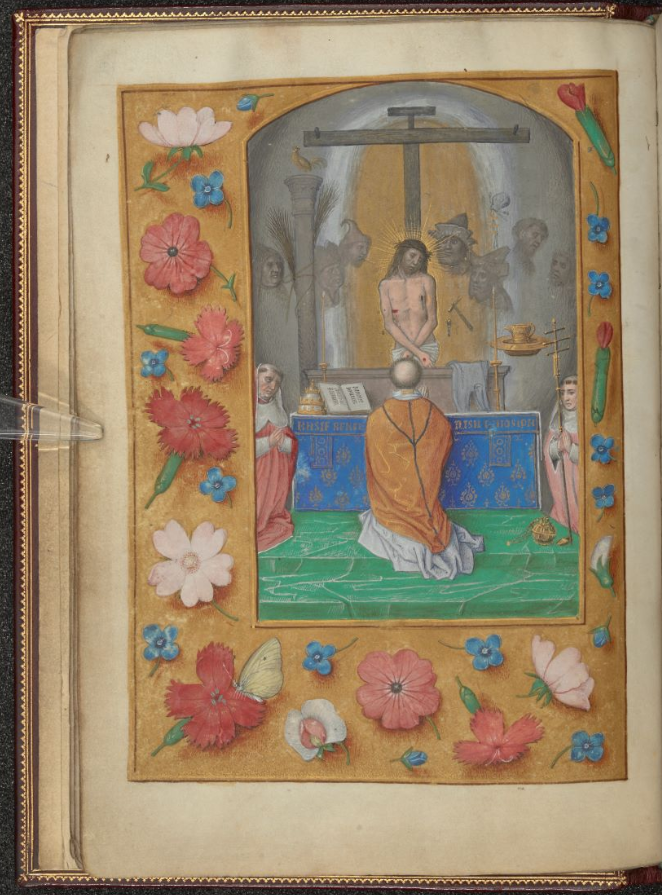After another 2 day visit to the Morgan Library, I am once again bulk-loading data. The first three books from this trip are:
- M.487 - An English MS from the 1490s, probably made for a small child as there are many more educational texts than usual. Saints are quite British, including David, Cedde, Richard and Cuthbert. Unusually St. Edward, King, on March 18 is in red. (DB Id: 233)
- M.116 - A French MS from Cambrai, made in the 1490s. It contains a fair selection of feasts unique to Cambrai, including Translation of St. Barbara on Feb 12, St. Waltrude on April 9 and St. Salvius (in red) on June 26th. It also contains both the feast, on August 11, and the Octave, on August 18 of St. Gaugericus of Cambrai. (DB Id: 229)
- M.1089 - An Italian MS, probably made in the Veneto around 1425-1450. The calendar is misbound, ff. 6-7 are first, then ff. 1-5 and 10-14, no folios are numbered 8-9. The calendar is sparsely populated, only 116 entries, and very red, more than 50% of the entries. There are a few entries that might indicate a Fransiscan influence and one unusual one, St. Daniel the Prophet listed on July 24, though his feast is July 21. This is unique, so far, in the corpus. (DB Id: 106)
Now that the Morgan Library MS block is complete for now, I've added a British book, one with quite an impressive history, British Library Add MS 50001. This use of Sarum book was owned by Queen Elizabeth, wife of Henry VII, and is actually inscribed to her on f.22r, "Elysabeth y[e] queene". The manuscript is a bit of a mess, it was rebound by the BL recently and digitized un the unbound state.
The calendar is very complicated. There are many of the liturgical notes in the margins (the Keys of Easter, extremities of Advent, etc) and the Zodiac dates. These are in blue ink, which is not elsewhere used in the calendar, excluding a single saint in August, until December, when they appear frequently, apparently used as a middle rank. Many of the usual "Henry VIII" editorials are visible, 'pp' or 'ppe' erased and the feasts of Thomas Becket (dec 29th and July 7), struck through entirely. The most interesting things about the calendar, however, are the mistakes. In the month of August(see f.4v below), all of the entries in black ink, up to St. Rufus on the 27th are one day too early, however the red entries are accurate. This suggests a phased approach to the scribe, with all of the black entries writted apart from the red ones, and perhaps that the black ones were done first.
And on a project note, this is the 100th Book of Hours to be entered in the DB!
(DB Id: 186)
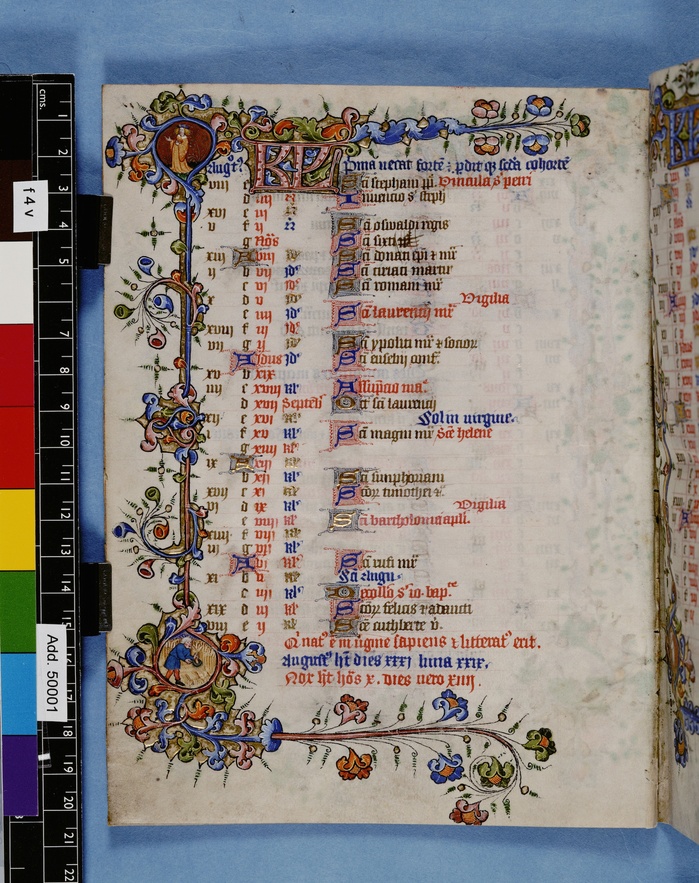
Down to the last* of the major set of Morgan Library books, M.99 is a very British book of hours, made at St. Peters, Gloucester around 1405-1415. Though trimmed and rebound the current size, about 8"x6", suggests originially it was quite a large book compared to many Books of Hours. The calendar contains, apart from the usual English saints, Oswald, Cedde, David, etc, multiple obituaries for local ecclestiacs and even the dedication of St. Peters, September 18th. As usual with British calendars, many of the 'pape' inscriptions have been erased, though Thomas Becket was untouched. There's an unusual error in the date information for December, after the Ides, the countdown to the Kalends starts at 18, rather than the accurate 19. This was caught somewhere during the work and, though not fixed, the line for III before the KL was duplicated, so at least there are the right number of entries.
(DB Id: 80)
* 2 Morgan MS remain, both are waiting on some additional information from the imaging department to be entered into the DB.
Taking a break from the Italian books, Morgan Library M.700, the Du Bois Hours, is a massive british Book of Hours, use of Sarum, dated to 1325-1330. It starts with a couple of full page illuminations, including a last-judgement, and then the calendar starts on f.5r, one side per month. It has most of the usual english saints and a couple of later additions in a regular, though difficult to parse, secretary hand. Oddly there is no title material for the months, no KL, no verses, not even the name of the month -- apart from it next to the Kalends for the 1st.
(DB ID: 79)
British Library Royal MS 2 A XVIII is a lovely Sarum use book, and the most entertainingly Tudor book possible. In addition to all of the relevant English saints, Edward the Confessor, Cuthbert and Etheldreda, there is the erasure of ALL references to Thomas Becket (see his Octave on f.28r) and even the title 'pape' has been removed where possible. The margins are filled with later notes about the goings-on with the royal household: "her decessed queene katerine", and "this day king harry the viith wedded the queen Elisabeth..."
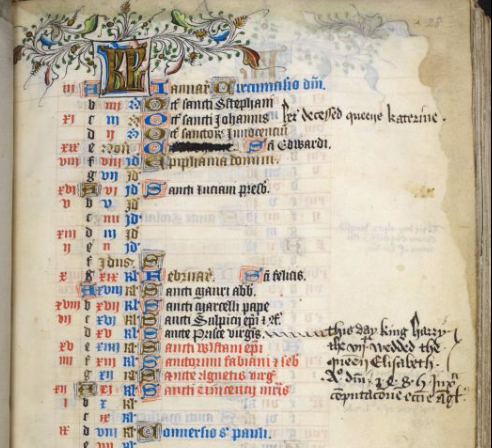
British Library Yates Thompson 29, known asthe 'Hours of Bonaparte Ghislieri', formerly known as 'The Albani Hours', is a lovely Humanistic Use of Rome book, from Bologna, about 1500. The calendar is decorated with the expected foliage and cameos, and the bottom of the first page of each month has an "important" saint, though not always one realated to the month. There's an interesting error in the months of May and June, may is incorrectly written with 30 days, ending with a dominical letter of 'c' (see f.5v below), which would have been right for May 30th. Either as an intentional correction or, more likely, as an error from the same cause, June has 31 days, and starts with dominical letter 'd'. The saint on the second line of June, however, is a correct saint for June 1, and the rest of the month continues in the same manner. There is no evidence for this practice, but if one were copying from a non-paginated calendar, this mistake would be easily possible
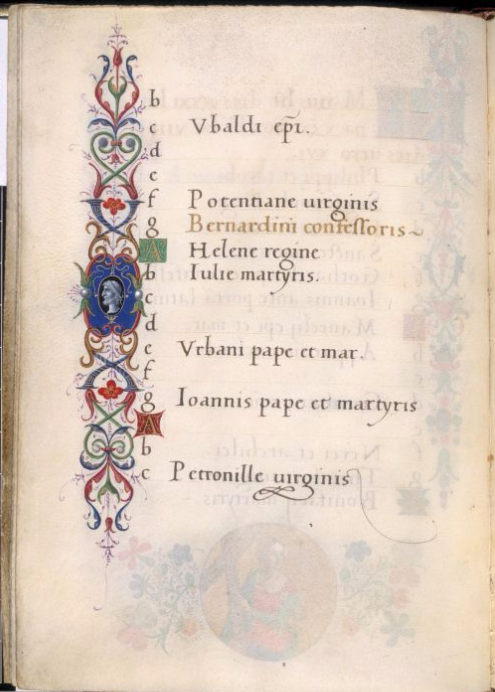
British Library Add MS 35313, known as the London Rothschild Hours, is another Flemish book of hours, this one probably made for a member of the Spanish court in the Netherlands. The complete calendar consists of only 6 folios, with one month per side. The decoration scheme is comprehensive, with the sign of the Zodiac at top, the labor of the month at bottom, and architectural roundels the full height of the outer edge representing the saints of the month. On the side of December, f.7r below, you can see the Nativity, the deaths of St. Thomas Becket and St. Stephen and a cephalophoric saint, among others. The calendar is interesting due to the large number of unusual saints, roughly 60, who were unmatched and their prevelance in March and April.
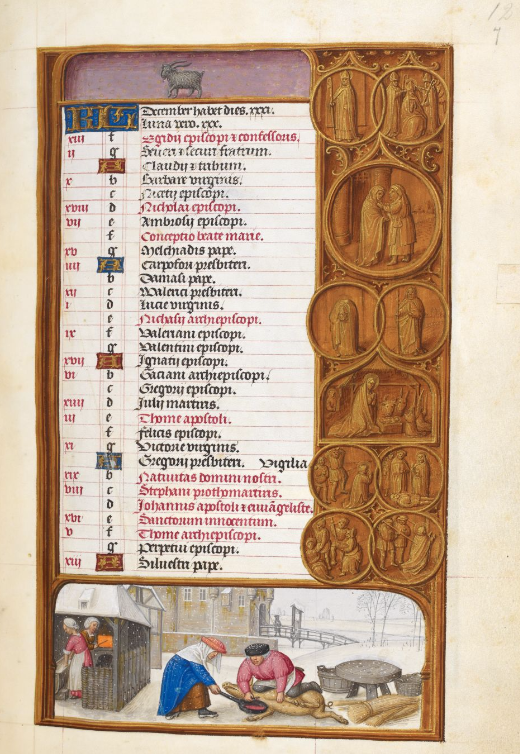
Something that has been on the "should do" list for a while and I finally did is a bulk loader for calendar entries. This is a command-line app that takes a csv file and inserts it into the DB of entries. It requires that the columns match the expectation, but there's an excel template in Git that makes that easy, and it requires that the calendar object is already there, as it takes calendar ID as it's argument. Running it looks like this:
[aaronm@Shamash bohdb]$ bin/loader.pl --csv ~/Dropbox/manuscripts/Books\ of\ Hours/Add\ MS\ 35313.csv --calendar=46
366 rows loaded from /Users/aaronm/Dropbox/manuscripts/Books of Hours/Add MS 35313.csv at bin/loader.pl line 47.
365 rows prepared to insert at bin/loader.pl line 83.
[aaronm@Shamash bohdb]$
This is rough code, we're doing direct SQL transactions rather than using the relevant Calendar object, but it makes the insert faster and lets the transaction work. At some point there will be a better loader, probably with a web interface, and that will do things "right". BL MS Add 35313 is the first calendar loaded with the new code.
The Hastings Hours, or MS Add 54782, is a Use of Sarum book held by the British Library. Though the calendar is somewhat undistinguished, some attribute the decoration scheme to Alexander Bening, father of the great 16th Century painter Simon. Though use of Sarum for th British market, it was made in Flanders and the calendar has not yet been localized. The Mass of St. Gregory, with it's illusionistic borders and halucinatory arma christi, from f.18v is reproduced below
